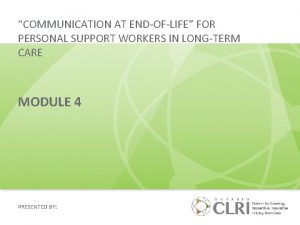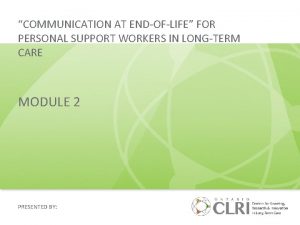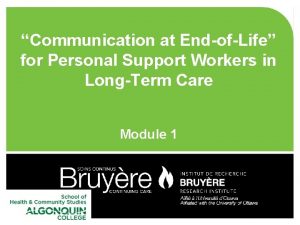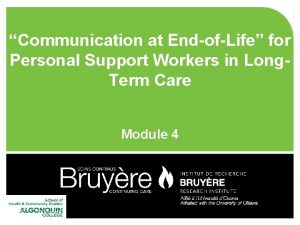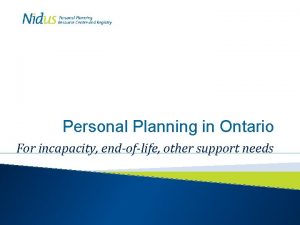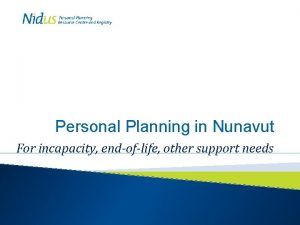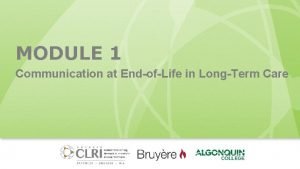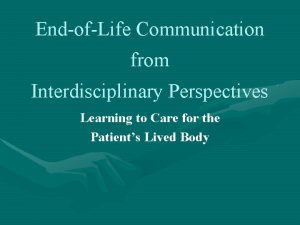Communication at EndofLife for Personal Support Workers in




















- Slides: 20

“Communication at End-of-Life” for Personal Support Workers in Long-Term Care Module 2

2 WHAT DO I THINK/FEEL ABOUT DEATH, DYING, AND LOSS? • Identify feelings and beliefs related to hospice palliative/end of life care • Explore personal values about death and dying • Explore personal experiences of grief and loss • Review Elisabeth Kübler Ross’s stages of Grief • Review William Worden’s Tasks of Grieving

PERSONAL VALUES ABOUT DEATH What are my personal values about Death? – Role? – Meaning? – Beliefs about life after death? – What I fear the most? – Preferences for when and where I die? Complete the handout on your own. After you finish, find one other person in the group and share some of your answers. Give your undivided attention as you share and listen. 3

4 ANSWER THE FOLLOWING QUESTIONS… • What was difficult to discuss; and why? • What was easier to discuss; and why? • How does it feel to discuss these topics with others? • What surprised you as you listened to someone else talk about death? • What did you learn about yourself in doing this exercise?

5 ACTIVITY: CHERISHED OBJECTS, VALUES, PEOPLE Create a list of objects, values, and/or people that you cherish in your life and that give you meaning and purpose for living.

GRIEF & LOSS VOCABULARY GRIEVING: A normal, natural, and individual (internal) response to a loss MOURNING: The process by which we publicly work through a loss. It is a form of healing and people need opportunities to experience this process. BEREAVEMENT: The event of loss 6

STAGES OF GRIEF DR. ELISABETH KÜBLER-ROSS 7

STAGES OF DYING/GRIEF • Denial • Anger • Bargaining • Depression • Acceptance 8

THE FOUR TASKS OF MOURNING DR. WILLIAM WORDEN (TEAR) TASK 1: TO ACCEPT THE REALITY OF THE LOSS TASK 2: EXPERIENCE THE PAIN OF THE LOSS AND EXPRESS IT WITHOUT JUDGEMENT TASK 3: ADJUST TO THE NEW REALITY WITHOUT THE LOST PERSON OR OBJECT TASK 4: RE-ESTABLISH AND RE-INVEST IN EMOTIONAL TIES 9

MANIFESTATIONS OF GRIEF PHYSICAL EMOTIONAL BEHAVIOURAL SPIRITUAL COGNITIVE 10

11 PHYSICAL MANIFESTATIONS OF GRIEF • Tightness in the throat • Shortness of breath • Disturbed sleep patterns • Loss of energy • Change in appetite • Dry mouth • Hollowness in the stomach • Tightness in the chest

12 BEHAVIOURAL MANIFESTATIONS OF GRIEF • Crying/sighing • Withdrawal of independence • Loss of interest • Restlessness • Hostile outbursts • Treasuring objects that belong to the deceased • Visiting places that remind the survivor of the deceased

13 EMOTIONAL MANIFESTATIONS OF GRIEF • • • Sadness and pain Anger hostility Personal guilt or shame (e. g. remorse, regret) Anxiety Loneliness and Helplessness Mood swings Shock Yearning Relief Numbness

14 SPIRITUAL MANIFESTATIONS OF GRIEF • • • Doubts about God/Higher Power/Creator Lack of belief or faith in a higher power Unable to pray, despair Guilt Dreams: seeing the deceased Hopelessness Decreased value of life Shame Regret Resentments

COGNITIVE MANIFESTATIONS OF GRIEF • • • Disbelief Confusion Foggy mind Poor memory Forgetfulness, absent minded Inability to concentrate Poor judgment Poor reasoning Perception distortion Ability to learn is compromised 15

16 LOVE AND GRIEF “Only people who avoid love can avoid grief. The point is to learn from it and remain vulnerable to love” -John Brant

LOVE AND GRATITUDE Love and Gratitude The agony is so great… And yet I will stand it. Had I not loved so very much I would not hurt so much. But goodness knows I would not want to diminish that previous love By on fraction of an ounce. I will hurt!! And I will be grateful to the hurt For it bears witness to The depth of our meanings, And for that I will be eternally grateful. -Author Unknown 17

NEEDS OF THOSE IN MOURNING 1. NEEDS OF THOSE SHARE FEELINGS - Allow people to ventilate their INand. MOURNING emotions fears 2. AFFIRM THEIR PERSONHOOD – Provide support and let them verbalize memories 3. FEEL SUPPORTED AND ACCEPTED – They may have fear of abandonment 18

NEEDS OF THOSE IN MOURNING 4. Expressions of DEPENDENCY are to be expected 5. To FIND MEANING IN THE DEATH EXPERIENCE – Do not minimize this. People expend massive amounts of psychic energy in the process 6. Need for REALITY-TESTING - To be reminded to stay in the present 19

20 DEATH ENDS A LIFE, BUT NOT A RELATIONSHIP
 Wound care study days
Wound care study days Health informatics jobs
Health informatics jobs Supporting details major and minor
Supporting details major and minor Fspos vägledning för kontinuitetshantering
Fspos vägledning för kontinuitetshantering Typiska drag för en novell
Typiska drag för en novell Tack för att ni lyssnade bild
Tack för att ni lyssnade bild Vad står k.r.å.k.a.n för
Vad står k.r.å.k.a.n för Varför kallas perioden 1918-1939 för mellankrigstiden
Varför kallas perioden 1918-1939 för mellankrigstiden En lathund för arbete med kontinuitetshantering
En lathund för arbete med kontinuitetshantering Kassaregister ideell förening
Kassaregister ideell förening Personlig tidbok för yrkesförare
Personlig tidbok för yrkesförare A gastrica
A gastrica Vad är densitet
Vad är densitet Datorkunskap för nybörjare
Datorkunskap för nybörjare Stig kerman
Stig kerman Mall för debattartikel
Mall för debattartikel Autokratiskt ledarskap
Autokratiskt ledarskap Nyckelkompetenser för livslångt lärande
Nyckelkompetenser för livslångt lärande Påbyggnader för flakfordon
Påbyggnader för flakfordon Arkimedes princip formel
Arkimedes princip formel Offentlig förvaltning
Offentlig förvaltning






















